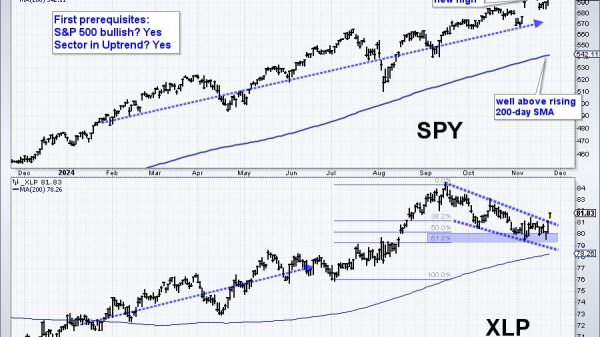Adam N. Michel
I recently testified before the Joint Economic Committee on why neutral, pro‐growth tax cuts are a more effective domestic industrial strategy than targeted subsidies for specific firms, industries, or technologies.
You can read my full testimony here and watch it here. I was joined on the panel by my colleague Scott Lincicome, who highlighted similar themes.
Here, I will expand on one of the points I make in my longer testimony. The tax code’s bias against physical investments is set to worsen over the coming years and is a particular hindrance to the manufacturing sector.
Fixing the tax code’s treatment of investments should be Congress’ top priority.
Industrial Policies for Manufacturing
The US has recently shifted its economic policy toward a more active centrally planned industrial policy model. It has done this, in part, through the CHIPS and Science Act and the Inflation Reduction Act, which include trillions of dollars in direct subsidies that the Biden administration has paired with regulatory prohibitions and trade restrictions.
Ostensibly, the investment is intended to boost the American manufacturing base, whose demise is much exaggerated. But there is one way US manufacturing is struggling: sluggish productivity growth.
In a recent article, economist Joseph Politano explains that “recent industrial policy has thus far been unable to solve American manufacturing’s greatest fundamental problem—its complete lack of productivity growth.” Former director of the Congressional Budget Office, Douglas Holtz‐Eakin, has noted a similar failure of recent federal efforts to jumpstart manufacturing productivity or manufacturing employment.
Focusing too narrowly on the manufacturing sector can distract policymakers from pursuing neutral, pro‐growth policies that benefit all sectors of the economy. However, because the manufacturing sector tends to rely heavily on physical investments and research spending, it’s an instructive case study of how the tax code may be standing in the way of economic progress.
Tax policy is not the solution to all economic problems. Trade, immigration, labor composition, regulatory burdens, and institutions play critical roles in determining our economic fortunes, but getting tax policy right makes other economic headwinds easier to overcome.
The Tax Code Makes It Harder to Invest
The tax code is fundamentally biased against investment because it taxes investment returns more heavily than wages—through taxes on capital gains, dividends, business income, and estates. The tax code also effectively denies businesses the full value of deductions for expenditures on physical investments, such as equipment and buildings.
Businesses pay taxes on the income they earn, minus deductions for expenses—leaving taxable profits. If the tax code denies the full deduction for certain investments, it will artificially increase the cost of investing.
Assets that last longer (have longer asset lives, according to the IRS) face the biggest tax penalty. Figure 1 shows that at sustained 3 percent inflation, the present value of a $1 investment deduction falls quickly for longer‐lasting assets.
For example, a business can only deduct about 88 percent of the real value of new equipment for vehicle manufacturing and assembly under the general depreciation system. Only 63 percent of investments in utility transmission infrastructure can be deducted.
The deduction value of a new manufacturing plant is eroded by as much as 60 percent over its 39‐year write‐off schedule. If a new semiconductor fabrication plant costs $1 billion and the new structure has to be depreciated over 39 years, Intel can only deduct roughly 1/39 (about $26 million) of what it paid to offset revenues in the first year. In 39 years, the final deduction of $26 million will be worth less than $3 million to the company. In the UK, the Adam Smith Institute has noted that a similar system creates a “Factory Tax” that largely falls on the investment‐heavy manufacturing sector.
Generally, assets fall into one of eight classes, each with different asset lives between three and 39 years. The Tax Cuts and Jobs Act (TCJA) of 2017 temporarily allowed businesses to use the full deduction immediately (called full expensing) for short‐lived assets (20 years or less). Beginning in 2023, this benefit phases out over five years, slowly making domestic investment more costly than it should be.
You can read more about expensing in my Cato Briefing Paper “Expensing and the Taxation of Capital Investment.”
Research Spending Plummets When Expensing for R&D Expired
Beginning in 2022, full expensing for research spending expired, requiring the costs to be amortized over five years (15 years for non‐domestic expenditures). Research expenses include related wages for the researchers and their supervisors and other attributable costs, such as rent, utilities, and overhead. Five‐year amortization effectively reduces the value of research deductions by about 13 percent (Figure 1), making research spending more costly after tax.
Figure 2 shows that the pre‐COVID‐19 average quarterly growth rate in real private R&D investment was 6.7 percent and 2021 R&D spending growth was even stronger. Following the loss of full expensing for R&D in the first quarter of 2022, R&D spending growth steadily declined, eventually turning negative. It averaged 2.3 percent through the first quarter of 2024—a 66 percent decline from the pre‐covid average.
Research spending provides a stark example of how tax policy can significantly affect investment behavior. Policymakers should expect similar effects across the rest of the economy as expensing for the remaining short‐lived assets continues to phase out over the coming years.
Bringing it Back to Manufacturing
Full expensing likely won’t solve the manufacturing sector’s slow productivity growth on its own, but it can make forward progress easier.
As we’ve seen over the last couple of years, targeted subsidies for particular types of investments tend to reshuffle existing resources toward politically favored sectors rather than expand the pool of total investment. There may be political returns, but the economic returns are usually disappointing.
Reforms like full expensing level the playing field between investments, expand investment opportunities, and lead to widely shared employment growth and wage gains.
In addition to making the TCJA full investment deductions permanent, Congress should also expand expensing to longer‐lived structures, either by allowing the same immediate deduction or implementing a “neutral cost‐recovery system,” which provides a similar economic benefit as expensing by allowing businesses to index their write‐offs for inflation and time.
Despite increased investment in a few narrow sectors, targeted subsidies have not resulted in a broader manufacturing renaissance, nor should we expect them to. Instead of reaching for additional activist measures to boost politically popular industries, Congress should remove existing barriers to investment in the tax code and repeal existing targeted industrial policy subsidies.
























